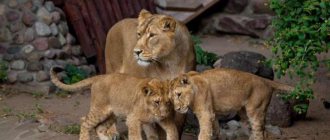The Moscow Zoo has existed for more than 150 years. It is the first to open in Russia. It was supported by donations from the imperial family, and its opening was initiated by the Russian Society for the Acclimatization of Plants and Animals. It was built according to the design of the architect Campioni, but most of the pavilions opened much later. The territory is divided into several exhibitions by region and animal species. In total, the zoo is home to about 8,000 species of animals, some of which do not hibernate, allowing visitors to visit it all year round. Before visiting the Moscow Zoo, you need to find out how it works in winter.
Is it worth visiting the zoo in winter?
A visit to the zoo is an excellent cultural program during the New Year holidays. You should not think that there is nothing to do on its territory during this period. You can visit the following animals during the cold season:
- orangutans - love to communicate with visitors, have incredibly smart eyes;
- red panda (or small) - a small animal, similar to a raccoon, with a bright coat color;
- penguins - in the capital's zoo they are not at all afraid of people; twice a day you can watch them feeding, when the birds receive fish directly into their beaks;
- meerkats will definitely make you smile, these animals spend all their free time looking after each other and live in a small flock;
- elephants move inside the pavilion for the winter, where they like to stand under the shower and joke with visitors (often dousing them with water);
- In the cold season, polar bears enjoy snow and low temperatures, and this is the time to watch them.
These are just a few species of animals that are worth visiting at the Moscow Zoo. If you are interested in watching the animals during feeding, you should check the feeding time on the website or by phone.
Little panda
The red panda is a cute, raccoon-like animal with a striped tail and the size of a large house cat. Because of its bright fur, the panda is also called a fiery fox, and because of its habits, it is called a cat bear. According to the results of recent genetic studies, the red panda was classified as a separate family - pandas (by the way, big pandas are not close relatives of small pandas, since they belong to bears).
The red panda lives in the southeastern part of the Himalayan mountains at an altitude of 2000–4000 meters above sea level. Small pandas are very sensitive to heat; they simply cannot tolerate temperatures above 30 degrees. Pandas find shelter in trees, often resting on branches, lying on their stomachs with all four paws hanging down. You can often see them in this position in the zoo. Although these animals are representatives of the order of carnivores, they feed only on plant foods. In captivity, in addition to special feed, they eat fruits, carrots, pumpkins, and their main delicacy is green bamboo leaves, which are brought for the pandas every two weeks straight from Sochi.
There are now two red pandas living in the Moscow Zoo. Recently, a young gentleman from Poland arrived to the female Zane. He is almost no longer afraid of her, although the female still feels like she is in charge of the situation and sometimes chases the newcomer. In retaliation, the male forced the obstinate lady out of her favorite place high above the ground, where she preferred to sleep.
Operating mode
In cold weather, the zoo's operating schedule will be as follows:
- from September to the end of November from 9:00 to 19:00;
- from the end of November to March from 9:00 to 17:00;
- in March-April – from 9:00 to 18:00.
The zoo has longer opening hours in the summer, when many schoolchildren and families want to visit and see a variety of animals. It is noteworthy that the establishment is open seven days a week, even in winter. You can even get there on January 1, but you need to find out the schedule further. It changes from year to year.
Orangutan
Orangutans are “forest people” from the Indian Ocean islands of Borneo and Sumatra. Red-haired, shaggy, with intelligent eyes, they carefully examine visitors and love to communicate with them. Keeping such advanced animals is a complex and interesting task. For example, it is not always possible to form a pair the first time, since when choosing a partner, orangutans are guided by their own preferences and likes, which do not always coincide with the opinions of people.
Nevertheless, zoologists manage to understand orangutans, because now the third generation of these monkeys lives in the Moscow Zoo. Two groups of orangutans live in two enclosures - Sumatran and Bornean. Each group has a male, females and cubs. During the first year of life, babies constantly sit on their mother; by the age of three, the little orangutan becomes more independent, but still communicates a lot with its mother. Baby orangutans are naughty and restless; teenagers play with each other for a long time.
Keepers constantly have to figure out what to do to keep the orangutans busy so that they don’t get bored in captivity: their developed intelligence needs an appropriate lifestyle. Therefore, orangutans are constantly given a variety of toys, rags and puzzles, from which the animals use chopsticks to extract their favorite treats - nuts and candied fruits. Some Moscow orangutans even draw with crayons.
Watching orangutans is very fascinating, especially when they dress up, play and communicate, because these primates do many things just like us.
How to get to the zoo
The oldest Russian zoo is located near the Garden Ring. It is easily accessible by ground and underground transport.
- The easiest way to get to the zoo is by using the metro. At the central entrance to this establishment there are two stations at once:
- "Barrikadnaya" (located along the Tagansko-Krasnopresnenskaya line);
- "Krasnopresnenskaya" (located on the Koltsevaya).
- There are also 3 bus stops near the park:
- next to the Krasnopresnenskaya station - trolleybus No. 66, buses No. M6, T79, 39, 64, 69, 116, 850, 869;
- trolleybus No. 66, bus No. 116 stop near Barrikadnaya;
- opposite the entrance located on Sadovo-Kudrinskaya there is a stop point “Malaya Nikitskaya Street”, there are buses T10, T39.869.
The territory has several entrances, the main one is located near the Barrikadnaya metro station, and the additional one is located on the side of Sadovo-Kudrinskaya Street. It is located between the Moscow Planetarium and the Terrarium. Through this entrance you can go directly to the new territory, but it is only open from 10 a.m. to 4 p.m. On Tuesday the additional entrance will be closed.
If for some reason the central entrance to the zoo is closed, then you can enter its territory through the entrance at Bolshaya Gruzinskaya, building 10 or at Krasnaya Presnya. In the first case, you will find yourself in a new territory, and in the second you can immediately visit the old part of the garden.
Meerkats
Meerkats are amazingly charming little animals that always bring a smile to everyone who sees them. These animals are a little like monkeys, a little like raccoons, and just a little like rodents. In reality, meerkats are predators and are related to mongooses. Living in the harsh conditions of the Kalahari Desert, meerkats also feed on animals whose poison kills humans. The main food of these nimble animals is insects and other invertebrates, as well as lizards, bird eggs, and small rodents. Meerkats also do not disdain scorpions and poisonous snakes.
Meerkats have a good sense of smell, which is necessary when searching for insects that burrow deep into the sand, and keen eyesight, which allows them to spot a predator from afar. The dark circles around meerkats' eyes absorb excess ultraviolet radiation, allowing the animals to look almost directly at the sun. Meerkats are unusually talkative creatures. While feeding, they constantly talk to each other, making quiet sounds. While some individuals dig in the ground, others always remain at their post and look around for danger. Meerkats live in families consisting of a dominant pair and its offspring. The life of each family is controlled by one main female: it is she who chooses the hole in which the family will live, the feeding place, and only she can bear cubs. If babies are born to other females, they may be kicked out of the group or even kill the newborns.
At the Moscow Zoo, meerkats are fed three times a day. Their menu includes cottage cheese, vegetables, fruits, quails and their eggs, chicken meat, but the animals are especially animated at the sight of mealworms, zofobas larvae and insects. Meerkats catch and eat them with lightning speed, often arguing and quarreling over the prey. Having had their fill, the animals huddle together and, forgetting all their quarrels, look after each other.
Pools for seals and walruses
In 2021, the inhabitants of the zoo will have a housewarming party. pavilion “Pinnipeds” will be completed for marine mammals . Marine inhabitants - walruses, sea lions, fur seals, seals - will have six spacious swimming pools at their disposal, and the new pavilion will recreate the natural habitat as much as possible.
In addition, the reconstruction of the pedestrian bridge that connects the old and new parts of the zoo will be completed. For the convenience of visitors, another entrance to the zoo will appear a few meters from the Barrikadnaya metro station.
A rare case: two Wonderoo macaques were born in a short period of time at the Moscow ZooIn honor of the Year of the Ox: Muscovites will choose names for the yak calves born at the zoo
Elephants
Another animal you can visit in winter is the elephant. In their families, like those of meerkats, matriarchy reigns. Females form groups consisting of female relatives, but adult males most often stay alone. The oldest female matriarch leads the family group. Because elephants grow throughout their lives, the oldest animals are usually the largest. They live long, up to 70–80 years. Social bonds between elephants are very strong. If one of the group members is injured, others come to his aid, help him stand up, supporting him on both sides.
Currently, three elephants live in the capital’s zoo: male Pamir, female Pipita and their daughter, six-year-old Kiprida. By the way, she has almost caught up with her mother in size. Pamir and Pipita came to the Moscow Zoo in 1985. Their story began with Vietnam giving Cuba several baby elephants. They safely crossed two oceans on a ship, but when the ship with the animals approached the island, the Cuban authorities refused the gift. By that time, the elephants had been at sea for several months. The Moscow Zoo agreed to accept them, and the ship set off for Leningrad, from where they traveled by train to the capital. Cyprida is already the fourth baby born to these elephants.
The animals spend the summer in outdoor enclosures, and in the winter they can be seen inside the pavilion. Each elephant eats about 150 kilograms of food daily. They eat grass or hay, potatoes, carrots, beets, bread, and always receive willow brooms. Elephants love bananas and apples. In winter, these animals happily stand under the shower, which is arranged for them in the elephant colony. Elephants sometimes like to play pranks with visitors: throw a lump of dung or spray them with water from their trunk, so be careful.
White bears
These animals do not hide in warm pavilions in winter; on the contrary, they are happy about the snow and frost and enjoy riding on the snow slides. There are three polar bears in the Moscow Zoo: the male Wrangel and the females Murma and Simona. The latter was born in a zoo. The rest ended up here after losing their parents in their natural habitat: Murma was picked up by Murmansk sailors, and Wrangel was picked up by biologists from Wrangel Island.
Most of the time the male lives with one of the females. Only before the appearance of the cubs is it resettled. Cubs are born in late autumn. For the first months they live in a den with a female bear, and come out in February-March. Last year, Simone gave birth to two bear cubs - a male and a female.
The first polar bear settled in the Moscow Zoo almost immediately after its opening - in 1871. Thirteen years later, Emperor Alexander III gave him two more. In Soviet times, bear cubs were often brought to the zoo from polar stations. In 1938, there were as many as eight representatives of this species here, but some of them died during the war. At the beginning of 1945, another bear cub was presented to the zoo by polar explorer I.D. Papanin.
In dens and refrigerators
This year, due to the warm autumn, bears are hibernating a little longer than usual. At the moment they rarely come out to visitors. Any day now they will lie down until spring. Even in the summer, they begin to be fed with fruits, fish and honey, so that their weight is acceptable for the long winter.
Although bears sleep fairly soundly, zoologists still ask visitors to be respectful and not make too much noise near their enclosures. And keepers monitor the animals’ sleep through a special window and 24-hour video broadcast. It happens that animals themselves wake up when a thaw sets in, but quickly fall back into hibernation. Also in winter, raccoon dogs may wake up and come out to find out if spring has come.
“Raccoon dogs spend the winter quite funny. They sleep together, huddled close to each other, and one by one they go out to investigate, check: how is the weather there? One will wake up, go out, see if there is sun, grass and food. If there is nothing, then he comes back and falls asleep again,” notes Svetlana Akulova.
Keepers help the animals prepare for hibernation : they lay out twigs and hay around the enclosure so that the animals can make special beds for themselves for hibernation. For example, back in October, zoo employees bring everything needed to the bears’ enclosure to create comfort in the den. Employees also lay out branches for the raccoons, which are used by the animals to insulate their burrows.
Marmots also make their own shelter. Females usually hibernate earlier than males - in October, as the marmot needs to gain more subcutaneous fat for winter sleep.
The jerboas fell asleep earlier this year: low temperatures arrived already in November. Rodents spend the winter in a refrigerator ; they are specially put into suspended animation: metabolic processes in the animals’ bodies slow down. For the next four to five months they will sleep in a wooden box lined with foam rubber. Keepers also monitor the jerboas; they periodically take them out and weigh them. If the animal has lost a lot of weight, then it is supplemented with fatty seeds and is again gradually introduced into suspended animation.
Jerboas at the Moscow Zoo were placed in refrigerators for the winter











